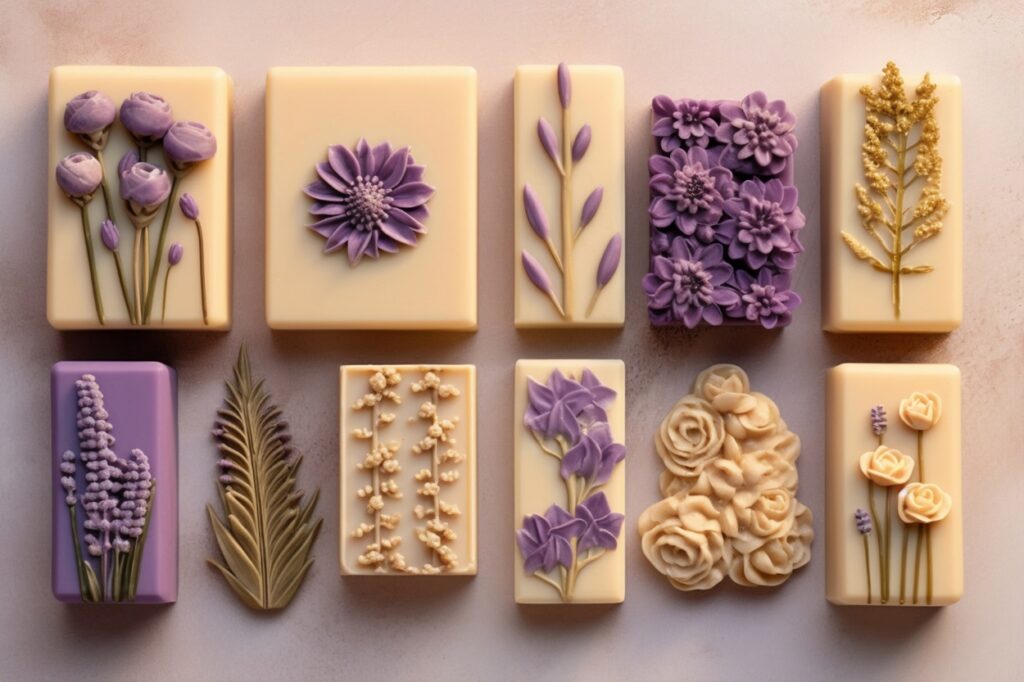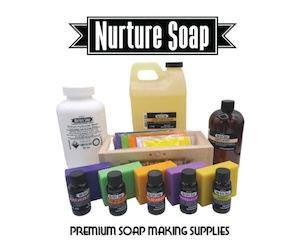Silicone Soap Molds:
In the craft of soap making, the choice of molds plays a pivotal role in shaping the final product. Silicone soap molds have emerged as a popular tool among soap makers, both hobbyists and professionals. Known for their flexibility, durability, and variety of designs, these molds have significantly simplified the soap making process. In this blog post, we will delve into the world of silicone soap molds, exploring their advantages, types, and maintenance, along with creative tips for soap makers.
Related Article: Soap Making Molds: Is There a “Best” Soap Mold And Why?

Advantages of Silicone Soap Molds
- Flexibility and Non-stick Surface: Silicone molds are highly flexible, making it easier to demold soaps without damage. Their non-stick surface ensures a smooth finish.
- Durability and Longevity: Resistant to heat and cold, silicone molds maintain their integrity over time and are less prone to cracking compared to plastic or wood molds.
- Variety of Shapes and Sizes: Available in an extensive range of shapes and sizes, silicone molds cater to diverse aesthetic preferences and purposes.
- Easy to Clean and Maintain: Silicone is easy to clean and can be safely washed in a dishwasher, saving time and effort in maintenance.
Types of Silicone Soap Molds
- Bar Molds: Ideal for making traditional bar soaps, available in various sizes and patterns.
- Loaf Molds: Used for making larger batches of soap that can be sliced into individual bars.
- Novelty Molds: Feature unique and intricate designs for creating themed or decorative soaps.
- Custom Molds: Tailored to specific designs or logos, perfect for branded or personalized soaps.
Using Silicone Soap Molds in Soap Making
- Pouring and Curing: Silicone molds can withstand a range of temperatures, making them suitable for different soap making methods. The flexibility of the mold allows for easy removal once the soap has cured.
- Design Flexibility: With their diverse designs, silicone molds enable soap makers to be creative with colors, patterns, and textures.
- Multipurpose Use: Beyond soap making, these molds can be used for making candles, chocolates, and other crafts, making them a versatile addition to any craft toolkit.
Maintaining Silicone Soap Molds
- Cleaning and Storage: Proper cleaning and storage are key to preserving the quality of silicone molds. They should be washed with warm water and mild soap and stored away from direct sunlight and heat sources.
- Avoiding Sharp Objects: To maintain the integrity of the mold, avoid using sharp objects that can tear or scratch the silicone.
Related Article: Cleanup & Safety Tips For Soap Making: Make It Simple!
Creative Tips for Soap Makers Using Silicone Molds
- Layering Colors and Textures: Experiment with layering different colors and textures for visually appealing soap designs.
- Embedding Objects: Silicone molds are perfect for embedding objects like flowers, herbs, or small toys into soaps for a unique look.
- Combining Molds: Use a combination of mold shapes and sizes for a diverse soap collection.
Challenges and Solutions with Silicone Soap Molds
While silicone molds offer many advantages, challenges such as soap batter sticking or air bubbles can occur. Solutions include using a light coating of mineral oil for easier release and tapping the mold to release air bubbles before the soap sets.
Eco-Friendliness and Sustainability of Silicone Molds
Silicone is a more eco-friendly option compared to plastic molds. It’s a durable material that reduces the need for frequent replacements, contributing to less waste. However, responsible disposal and recycling practices are important as silicone is not biodegradable.
Innovations and Trends in Silicone Soap Molds
The market for silicone soap molds is continually evolving, with new designs and functionalities being introduced. Recent trends include 3D molds and molds with interchangeable inserts for customizable designs.
Tips for Using Silicone Soap Molds
| Tip | Description | Application |
|---|---|---|
| Temperature Resistance | Silicone molds can withstand a wide range of temperatures, making them suitable for both cold process and melt-and-pour soaps. | Use confidently with different soap making methods without fear of damage. |
| Minimal Greasing | Due to their non-stick nature, silicone molds require minimal to no greasing. If needed, a light coating of mineral oil can aid in easier release. | Apply a thin layer of oil using a brush for intricate designs to ensure smooth release. |
| Easy Removal | The flexibility of silicone allows for easy removal of the soap without distorting the shape. Gently push from the bottom or sides of the mold. | Be patient and gentle when demolding to maintain the integrity of intricate designs. |
| Creative Layering | Silicone molds are perfect for creative layering of colors and textures in soap making. | Experiment with different colors and additives in layers for visually appealing soaps. |
| Embedding Techniques | Ideal for embedding items like dried flowers, herbs, or toys due to their clear definition and shape retention. | Place the item in the mold and pour soap batter over it, ensuring it’s fully covered. |
| Reducing Air Bubbles | Tapping the silicone mold on a hard surface can help release any air bubbles in the soap mixture. | Fill the mold and gently tap to avoid air pockets and ensure a smooth surface. |
| Cleaning and Care | Wash with warm water and mild soap. Avoid using abrasive cleaners or pads. Store in a cool, dry place away from direct sunlight. | Proper maintenance extends the life of the molds and ensures clean, crisp lines in your soaps. |
| Avoiding Sharp Tools | Do not use sharp or metal tools to cut or remove soap from silicone molds, as they can tear or scratch the material. | Use plastic or silicone tools if needed to assist in removal or cutting. |
| Versatility in Crafting | Silicone molds can be used for a variety of crafts beyond soap making, such as candle making, chocolate making, and more. | Explore different crafting uses to maximize the utility of your silicone molds. |
| Customizing Soap Sizes | For larger molds like loaf molds, cut the soap to your desired size after it has fully set. | Use a non-serrated knife or soap cutter for even and clean cuts. |
Related Article: How to Properly Insulate Cold Process Soap?
Final Thoughts
Silicone soap molds have revolutionized the world of soap making, offering a blend of functionality, durability, and creative freedom. Whether you are a beginner or an experienced soap maker, these molds can enhance your soap making experience, allowing you to explore endless possibilities in soap design. With proper care and creativity, silicone soap molds can be a valuable asset in your soap making journey, helping you create beautiful, professional-quality soaps with ease.



